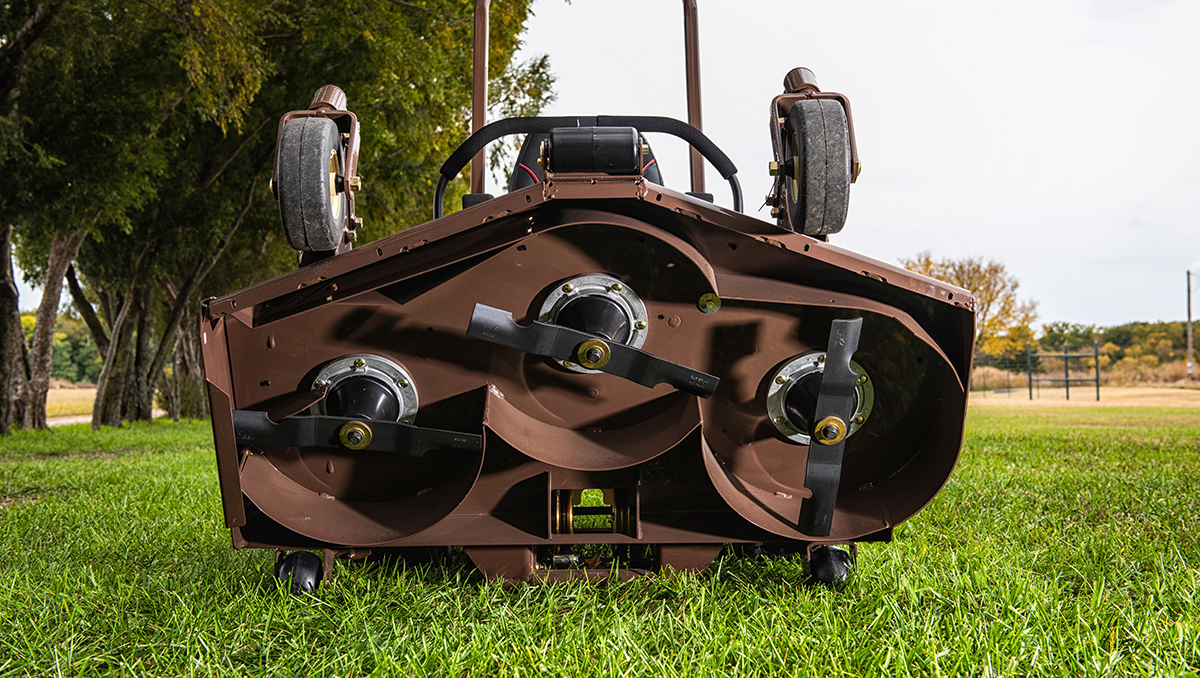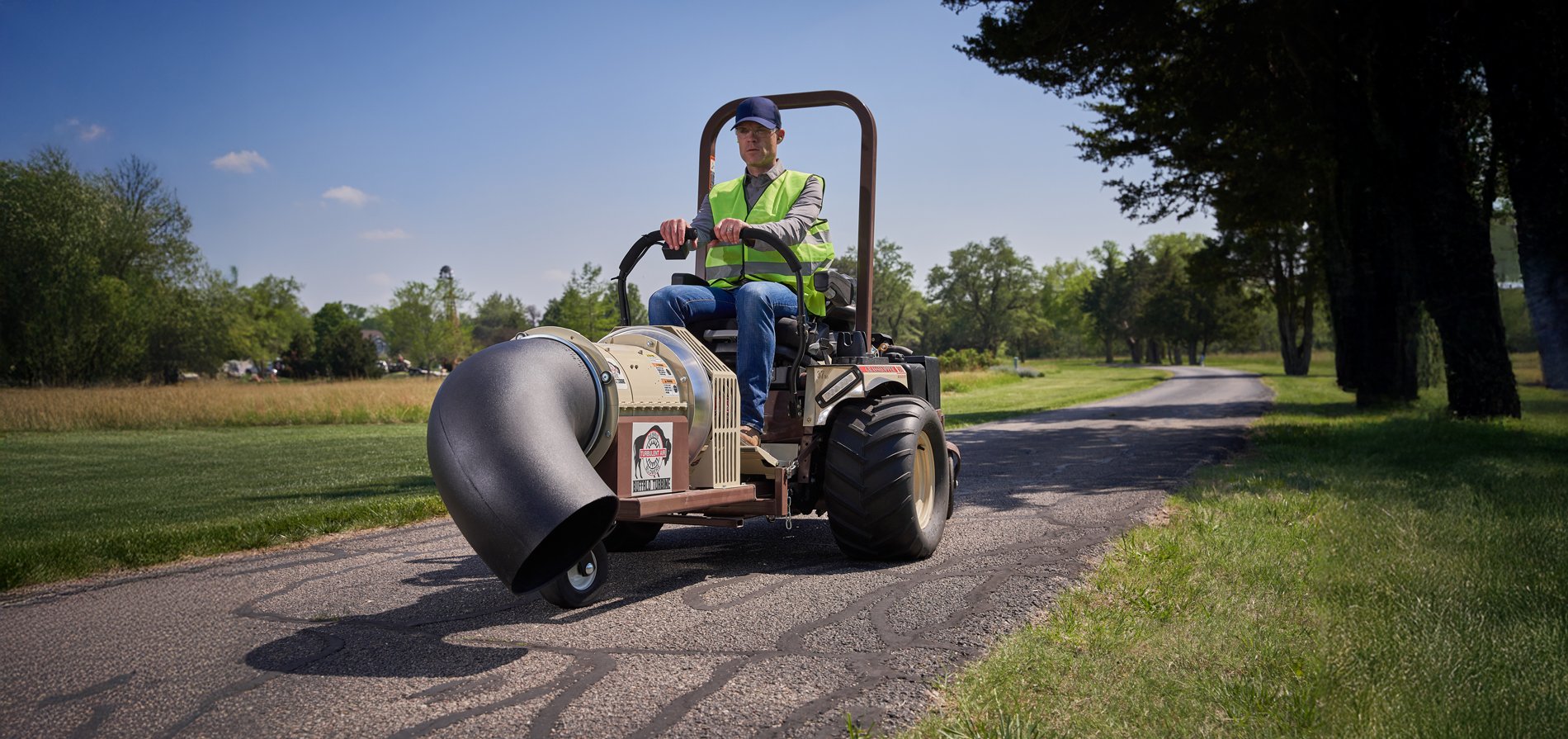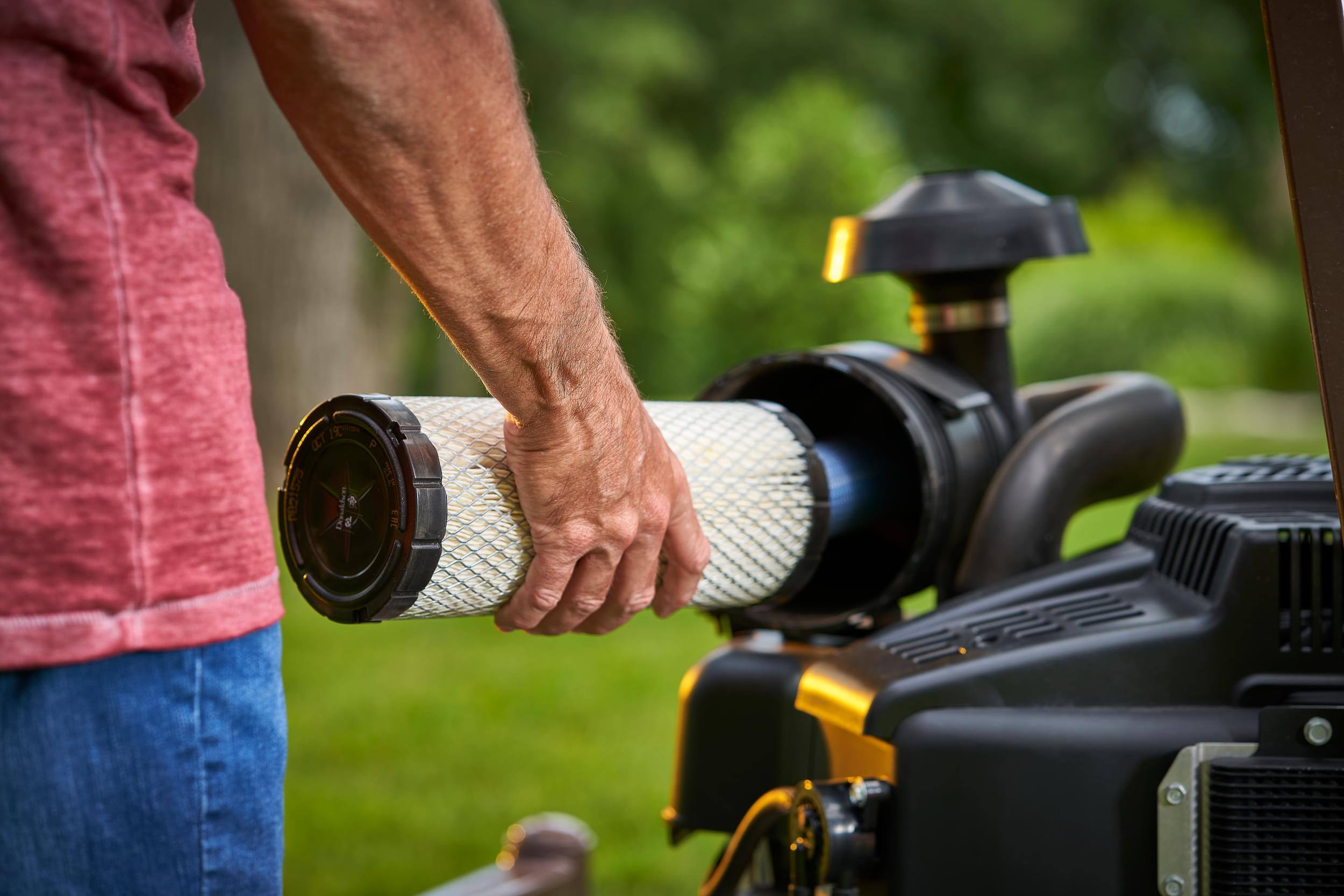The seasons are changing once again. Whether you’re looking to start using your Grasshopper mower to plow, blow or sweep snow, or simply want to park it until next spring, there are some important maintenance steps that will help ensure your mower is as ready for winter as you are.
Transforming your mower into a winter workhorse
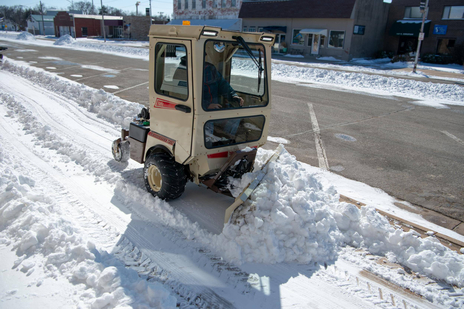
Battery check. Colder temperatures can really put a battery to the test. Give yours a thorough inspection, looking for cracks, leaks or signs of corrosion. This includes not only the battery case itself, but also the cables, terminals, battery tray and hold-downs. If everything checks out all right, be sure to fully charge the battery and keep it fully charged throughout the winter.
Keep the engine warm. If you’re in a really cold environment where the temperature regularly dips below 0°F, ask your Grasshopper dealer if you could have a block heater installed. This will provide heat to the engine when it isn’t running. Grasshopper offers block heaters for models equipped with Kubota engines. You could also ask your dealer if there is a carburetor anti-icing kit available for your engine manufacturer.
Additionally, if your mower has a diesel engine, check that all glow plugs are in good condition. Glow plugs assist engine starts in cold weather. Refer to your engine manual to familiarize yourself on the proper way to use the glow plugs to preheat the engine cylinders.
Keep the operator warm. Staying on the topic of keeping warm, you may be able to take advantage of a popular Grasshopper add-on feature. If you own a 700 or 900 Series Grasshopper power unit, a fully enclosed Metal Winter Cab is available. Grasshopper’s most modern cabs (2018 and newer) come standard with LED lights. Several additional features are also available, including an electric windshield wiper, a roof-mounted strobe beacon light for added visibility and safety and a 16,000-BTU heater kit for liquid-cooled power units.
Use the right oil. Winter operation requires an engine oil that provides cold-weather protection and performance. For example, the lower-viscosity 30-weight oils that are popular during the mowing season, such as SAE 30 and 10W-30, could lead to starting issues in the winter. Be sure to check your engine owner’s manual for cold-season oil recommendations.
Use the right fuel. It’s important to use fresh, winter-grade fuel that’s blended to allow for better cold-weather starts.
Even when purchasing a high-quality, winter-grade fuel, consider adding a fuel stabilizer. Winters are unpredictable, and it’s possible your mower may not be needed to move snow for several weeks at a time. A fuel stabilizer will help keep that fuel fresh for optimum performance when it is needed. Similarly, if you’re buying your fuel in bulk, adding a good fuel stabilizer is a wise, proactive measure to take.
Give things a chance to warm up. It’s always important to allow your engine to warm up a bit in cold weather. Start the engine and allow it to run at low- to mid-throttle for several minutes before setting it to full throttle and going to work.
Preventive maintenance for off-season storage
If you aren’t planning to use your Grasshopper mower for snow removal or other tasks during the winter, there are still some essential steps to help prepare it for off-season storage.
NOTE: For safety purposes, disconnect the spark plug before executing the first series of postseason maintenance procedures.
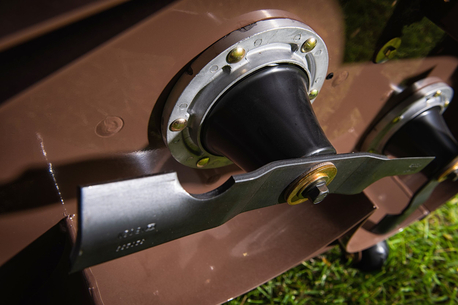
Inspect blades and belts. While safely accessing the underside of the deck, remove the blades for a thorough inspection. Sharpen or replace as needed. Also give the belts a thorough inspection. If you notice any warping or excessive wear, make sure they are replaced with a genuine Grasshopper replacement before you start mowing again in the spring.
Clean the underside of the deck. While safely accessing the underside of the deck, take the time to thoroughly remove any caked-on grass.
Oil and filters. You want to make sure your mower has fresh oil before you start mowing again in the spring. You could always wait until spring to perform that oil change, or you could just take care of that procedure before putting the mower into off-season storage. Likewise, you could also take care of changing the oil, air and fuel filters.
Tires. Inspect tires for leaks and excessive wear, and repair or replace as needed. If all looks well, check the tire pressure and make sure tires are properly inflated before putting the mower into storage.
Spark plugs. Spark plugs should generally be replaced every 100 hours of operation; refer to your engine owner’s manual for specified intervals for replacing the spark plugs. Give yours a quick inspection. If you notice any signs of corrosion, fouling or damage, replace it.
NOTE: Reconnect the spark plug to execute the remaining items on your postseason maintenance checklist.
Clean the outside of the mower. Blow off any grass clippings, dirt or other debris with a leaf blower or compressed air. Avoid using a pressure washer, as water can infiltrate bearings and other fittings which can cause corrosion, diminished performance and premature failures of critical components. If you notice any gas or oil stains anywhere, WD-40 is a common household item that will help remove them.

Deal with any leftover fuel. If there is still some fuel left in the tank, add some stabilizer to keep it fresh until next spring rolls around. The other option is to run the mower until the fuel is burned up, or take proper measures to safely drain or siphon the fuel from the mower’s tank into a gas can.
Park the mower for storage. Ideally you have a heated garage or other storage facility to park your mower for the winter. At the very least, make sure the mower can be kept dry and out of the elements. If indoor storage is not available, a carport, lean-to or covered porch is preferable to letting the mower sit in the open exposed to rain, snow, wind and sun for the duration of winter. In addition, consider covering the mower with a tarp or a custom-fit Grasshopper Weather Cover.
Protect the battery. Leaving your mower battery in a cold environment all winter can result in battery failure. Since you’re storing your mower all winter anyway, a simple measure is to remove the battery and store it in a warm, dry area. If you’re storing your mower in a location that will remain dry and not get too cold, you could leave the battery in the mower, but consider disconnecting the battery cables. Another option for leaving the battery in the mower, even in a cold environment, is to use a product called the Battery MINDer®. Available through Grasshopper, a Battery MINDer keeps the battery charged all winter without the risk of overcharging.
By following these postseason rules of thumb, your Grasshopper mower will be ready when you need it–whether that’s the next time it snows or next spring when the grass starts to grow.

